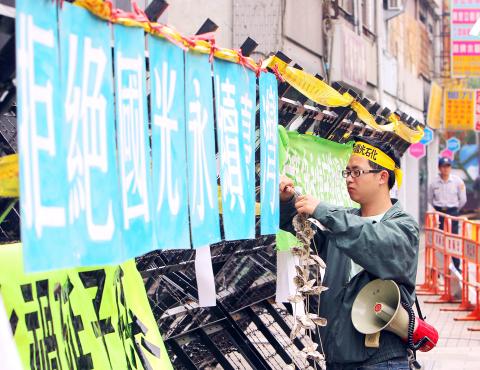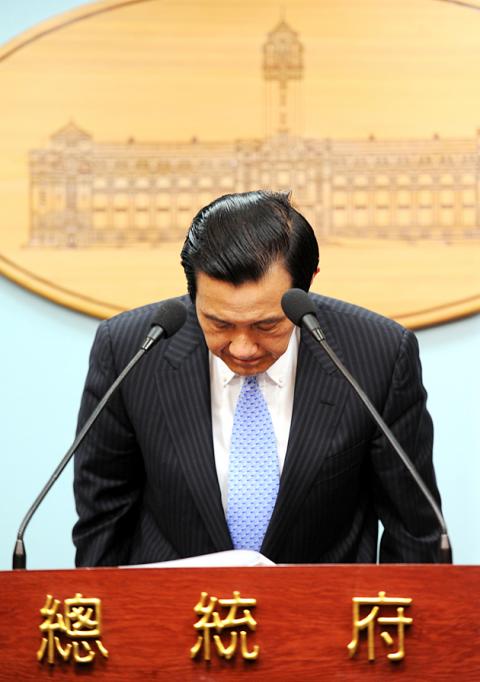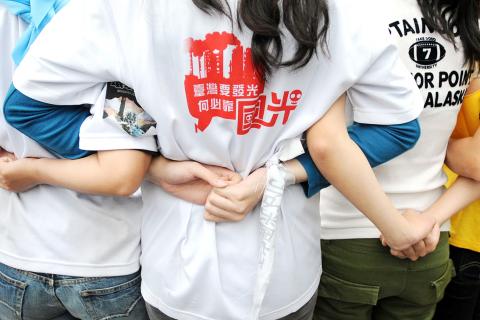A review taskforce yesterday failed to reach a final conclusion on the future of a proposed Kuokuang Petrochemical Technology Co’s (KPTC, 國光石化) naphtha cracker complex and proposed two scenarios to be evaluated by the Environmental Impact Assessment (EIA) Committee next month, a decision that did not please environmentalists.
EIA Committee member Chiang Pen-chi (蔣本基), who presided at the meeting, said the two options were that the committee either reject the project, which was planned to be constructed in Dacheng Township (大城), Changhua County, or give it conditional approval. In all, 11 reasons were given as to why the project should be abandoned and 24 conditions were listed if conditional approval were given.
About 40 minutes after the second day of meetings by the taskforce concluded at 3pm, President Ma Ying-jeou (馬英九) told a press conference at the Presidential Office that he opposed building the project in Changhua County.

Photo: CNA
Leading top government officials in explaining the government’s position on the matter, Ma said the complex, which was to be built in a wetland area, would have an “unbearable” impact on the local ecology and environment, and that the government should take the initiative in halting the project.
“The impact caused by the complex would be unbearable for the town and its people, and as an arbiter, it’s time for us to declare our stance,” Ma said.
“However, we will not and cannot give up on the petrochemical industry,” he said, adding that the Cabinet would start a thorough examination on the development of the industry.

Photo: Lo Pei-der, Taipei Times
Ma said the Council of Economic Affairs would instruct state-run refiner CPC Corp, Taiwan (CPC, 台灣中油), the largest shareholder of KPTC, to reject building the complex in Changhua during a shareholders’ meeting next week.
CPC Taiwan holds 43 percent of Kuokuang’s shares, with the remaining 57 percent held by private investors.
“I know [halting the project] is a difficult decision to make and the decision will have a substantial impact on the petrochemical industry and Dacheng Township,” Ma said. “However, the decision gives us a chance to seek balance between economic development and environmental protection.”

Photo: Wang Yi-sung, Taipei Times
Ma said the decision was made after a series of discussions on the issue with environmental groups, local residents and experts. He denied the decision was made to please local residents for electoral purposes.
Ma accused the Democratic Progressive Party (DPP) of planning the complex and leaving the thorny issue for his administration, adding that his administration took the responsibility to solve the problem when it was determined that the proposed site was inappropriate.
The Council of Economic Affairs will also assist KPTC in weighing other options, including moving the complex abroad, while helping the township create more employment.
Minister of Economic Affairs Shih Yen-shiang (施顏祥) said it would be difficult to find another location in Taiwan for the complex, which required a large plot of land, but declined to confirm whether the ministry would move the project to another country.
When asked about the negative impact of the halted complex on the local economy and the development of the petrochemical industry, Shih said the ministry would ensure the supply chain remained sufficient, adding that a cross--departmental discussion on the development of the industry would be held.
Yesterday’s decision by the taskforce and Ma’s announcement were met with a cool response from environmental activists, who had staged sit-in protests in front of the Environmental Protection Administration (EPA) for three days.
After the ruling, protesters called yesterday “a sad Earth Day.”
Representatives said they refused to buy Ma’s declaration and said his exclusion of Changhua from the list of possible sites for the proposed complex was simply intended to shift the focus of the issue.
The environmentalists refused to meet Ma at a traditional meeting to observe Earth Day and instead held a demonstration outside the Presidential Office to demand that the project be scrapped altogether.
Although Presidential Office spokesman Lo Chih-chiang (羅智強) tried to soothe the angry crowd and invite some of them into the office, they refused the offer and insisted they would not make any concessions over the matter.
The discontent also spread to two experts on the taskforce — Chan Chang-chuan (詹長權) of National Taiwan University and James Liu (劉祖乾) of National Chung Shan University — who said they were not pleased with the turn of events.
“The ruling was pre-determined and deviates from professional judgment,” Chan said. “This sets a bad example for the public. How could such an irresponsible and equivocal decision be made?”
Chan also accused Chiang of being reluctant to put the project to a vote, adding that the way Chiang interpreted the information differed markedly from most people’s understanding.
Commenting on the ruling, KPTC chairman Chen Bao-lang (陳寶郎) said the company would carefully study the terms of the ruling and then discuss them with its shareholders.
The EIA committee has held 24 meetings over the location of the plant. While experts on the committee have evaluated the project’s negative impact on the environment, Chen said they have never addressed the positive contributions the project would make to the economy.
Asked whether the company was contemplating other locations for the complex, Chen said the company had yet to discuss such options.
However, sources at the EPA said KPTC was likely to drop the bid before the EIA members meet at the general assembly next month, as Ma had clearly indicated his stance on the issue.
ADDITIONAL REPORTING BY CNA

Taiwan is gearing up to celebrate the New Year at events across the country, headlined by the annual countdown and Taipei 101 fireworks display at midnight. Many of the events are to be livesteamed online. See below for lineups and links: Taipei Taipei’s New Year’s Party 2026 is to begin at 7pm and run until 1am, with the theme “Sailing to the Future.” South Korean girl group KARA is headlining the concert at Taipei City Hall Plaza, with additional performances by Amber An (安心亞), Nick Chou (周湯豪), hip-hop trio Nine One One (玖壹壹), Bii (畢書盡), girl group Genblue (幻藍小熊) and more. The festivities are to

Auckland rang in 2026 with a downtown fireworks display launched from New Zealand’s tallest structure, Sky Tower, making it the first major city to greet the new year at a celebration dampened by rain, while crowds in Taipei braved the elements to watch Taipei 101’s display. South Pacific countries are the first to bid farewell to 2025. Clocks struck midnight in Auckland, with a population of 1.7 million, 18 hours before the famous ball was to drop in New York’s Times Square. The five-minute display involved 3,500 fireworks launched from the 240m Sky Tower. Smaller community events were canceled across New Zealand’s

‘IRRESPONSIBLE’: Beijing’s constant disruption of the ‘status quo’ in the Taiwan Strait has damaged peace, stability and security in the Indo-Pacific region, MOFA said The Presidential Office yesterday condemned China’s launch of another military drill around Taiwan, saying such actions are a “unilateral provocation” that destabilizes regional peace and stability. China should immediately stop the irresponsible and provocative actions, Presidential Office spokeswoman Karen Kuo (郭雅慧) said, after the Chinese People’s Liberation Army (PLA) yesterday announced the start of a new round of joint exercises around Taiwan by the army, navy and air force, which it said were approaching “from different directions.” Code-named “Justice Mission 2025,” the exercises would be conducted in the Taiwan Strait and in areas north, southwest, southeast and east of Taiwan

UNDER WAY: The contract for advanced sensor systems would be fulfilled in Florida, and is expected to be completed by June 2031, the Pentagon said Lockheed Martin has been given a contract involving foreign military sales to Taiwan to meet what Washington calls “an urgent operational need” of Taiwan’s air force, the Pentagon said on Wednesday. The contract has a ceiling value of US$328.5 million, with US$157.3 million in foreign military sales funds obligated at the time of award, the Pentagon said in a statement. “This contract provides for the procurement and delivery of 55 Infrared Search and Track Legion Enhanced Sensor Pods, processors, pod containers and processor containers required to meet the urgent operational need of the Taiwan air force,” it said. The contract’s work would be